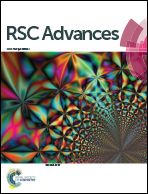Charge transfer mechanism of SERS for metal–molecule–metal junction supported by graphene and boron-doped graphene
Abstract
The Raman and absorption spectra of a Ag2–PATP–Au2 junction adsorbed on graphene and boron-doped graphene were investigated by using density functional theory (DFT) and time-dependent DFT methods. The interactions between the graphene and junction result in charge transfer (CT) from the graphene to the junction due to their different work functions. This CT leads to charge redistribution on the junction, and then the changes of static polarizabilities, which directly influence the enhancement of normal Raman spectra. The absorption spectra show that the graphene and boron-doped graphene induce some CT excited states in the visible and infrared regions. When the energy of incident light is close to the energy of these CT excited states, these electronic transitions will be excited, which leads to the enhancement of pre-resonant Raman scattering (pre-RRS) spectra. In pre-RRS spectra, the B-doped model has stronger Raman intensities, since it produces more CT excited states with intense oscillator strength near the incident light than the graphene model. The non-totally symmetric modes (b2) are strongly enhanced as well as the totally symmetric modes (a1), indicating the contribution of Herzberg–Teller (HT) scattering. The charge difference densities (CDDs) method was employed to directly visualize the CT from the graphene sheet to the molecule.


 Please wait while we load your content...
Please wait while we load your content...